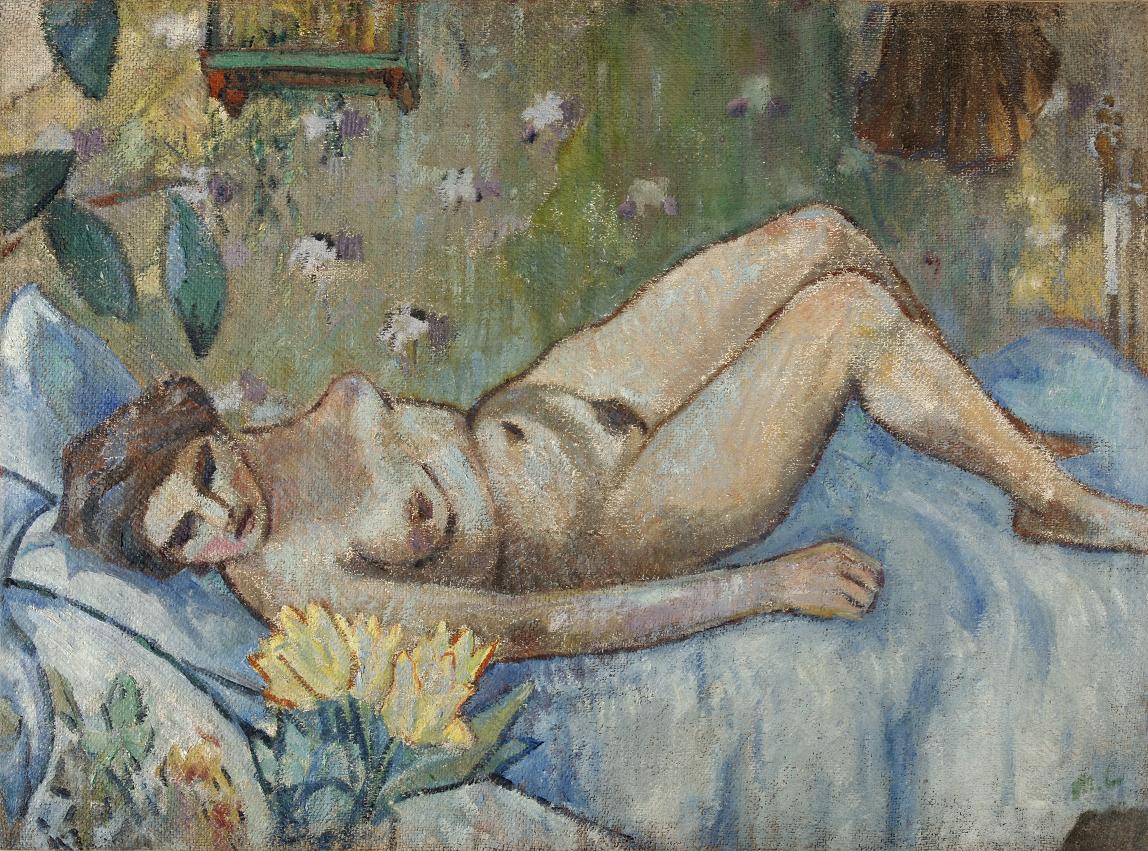26 November 2014 Russian Art Auctions
26 November 2014

*§ 27. LARIONOV, MIKHAIL (1881-1964)
Reclining Nude, signed with initials, further inscribed "Odessa", titled and dated 1902 on the reverse.
Oil on canvas, 71 by 96 cm.
1,500,000-2,000,000 GBP
Provenance: Acquired directly from the widow of the artist, Alexandra Tomilina, by the previous owner.
Private collection, Europe.
Russian Art Evening, Sotheby’s London, 24 November 2008, lot 34.
Acquired at the above sale by the present owner.
Important private collection, Europe.
Mikhail Larionov’s Reclining Nude belongs to a wonderful series of the artist’s life paintings from the years 1906–1908 and is perhaps one of
the most poetic compositions of this period.
In a sense, Reclining Nude became the summation of a whole series of “female bathers” painted in the 1900s (Female Bathers, 1905–1906, Three Female Bathers with a Rose, 1904–1906). The same precise brown outline is seen here, as was invariably the case in his canvasses of the first five years of the 1900s, marking out the figures of the bathers on the shimmering texture of the painted surface. However, the way the paint is built up in Reclining Nude is undoubtedly based on a different chromatic principle. The essence of this metamorphosis may be defined as a transition from organising colour impressionistically, without dividing lines, to doing so in an orderly, structured design. The colour becomes purer, more vibrant and local. There is a noticeable generalising tendency in the colour, a foretaste of new approaches to painting coming to take over from Impressionism. The last of Larionov’s “female bathers”, and particularly his Reclining Nude, are undoubtedly a striking and significant testament to Post-Impressionism in Russian art.
There is also an extraordinarily interesting fragmentary quality that finds expression in the picture, a deliberate “randomness” that characterises Larionov’s work of that time. It is as though the model is surrounded above and below by a world of nature morte including itself naturally and directly in the composition. The fragments left “outside the frame” convey a feeling of the freedom and space of the perceptible world, allowing Larionov’s carefully thought out composition to appear to have fallen into his field of view by mere accident as a tiny part of this huge world. Reclining Nude is the work through which the main vector in the development of Larionov’s painting passes on its way towards the famous Venus cycle of 1912–1913.
On the reverse of this canvas, that was inherited by Alexandra Tomilina
and has impeccable provenance, is the date “1902” in Larionov’s hand. This date was the result of Larionov “ageing” his early work in the 1940s and 1950s when he wanted, if not to be, then at least to seem to have been the artist who led the way in as many developments in painting as possible. Stylistic analysis gives good reasons to suggest that the picture dates back to 1906–1907, the period when the artist was moving away from Impressionism to Primitivism. At this point, Larionov started to actively
employ Fauvist “exacerbation of colour”, which is certainly visible in the present work. Yet there is still “Impressionist shimmer” and the softening of colour scheme, typical of the 1900s. As per Larionov’s own “reconstruction” of his creative path, life paintings, such as the temperamental, Gauguinesque Gypsy and Reclining Nude should have appeared in the early 1900s, predating the first Pointillist and Primitivist experiments in Europe.
Notes on symbols:
* Indicates 5% Import Duty Charge applies.
Ω Indicates 20% Import Duty Charge applies.
§ Indicates Artist's Resale Right applies.
† Indicates Standard VAT scheme applies, and the rate of 20% VAT will be charged on both hammer price and premium.